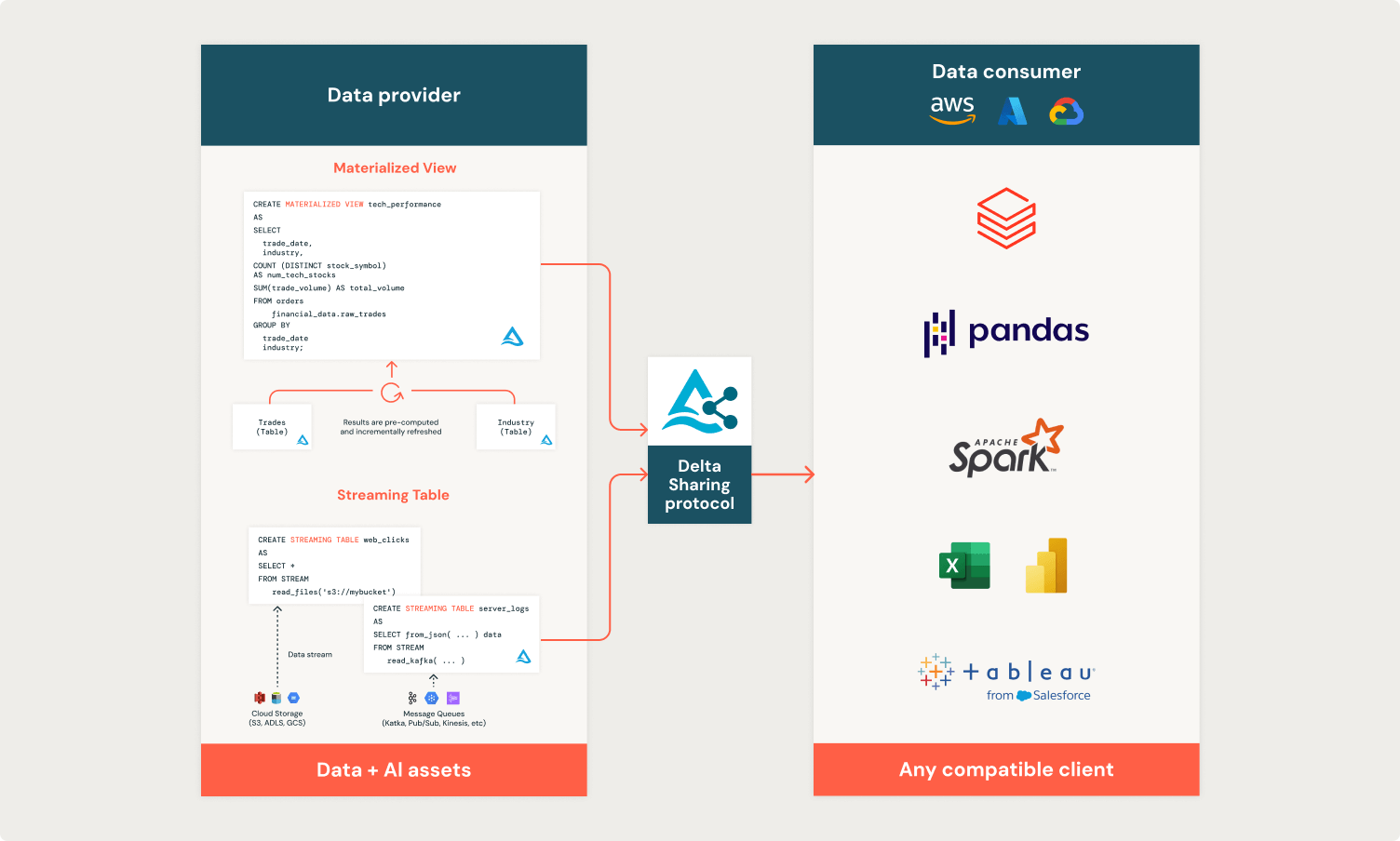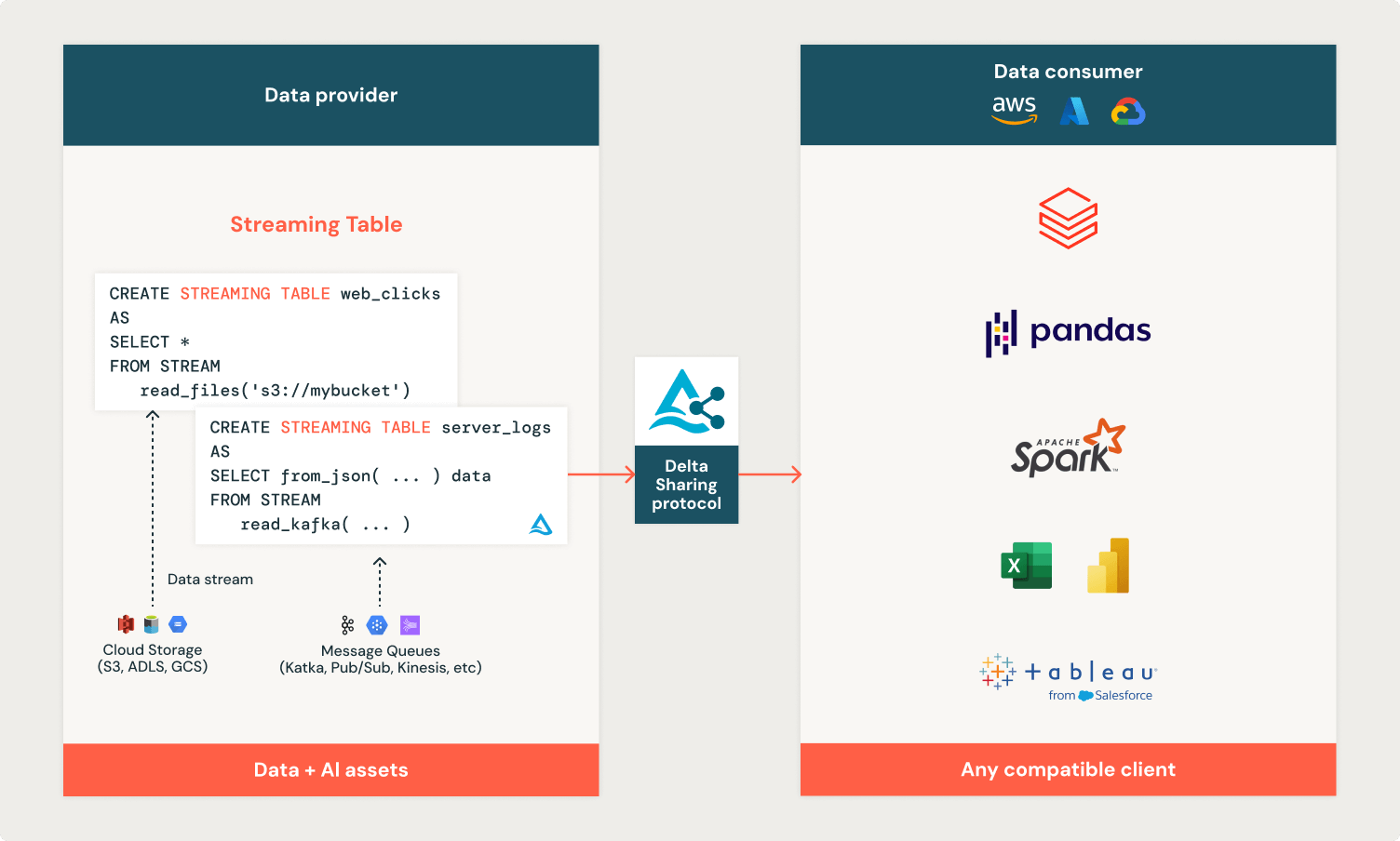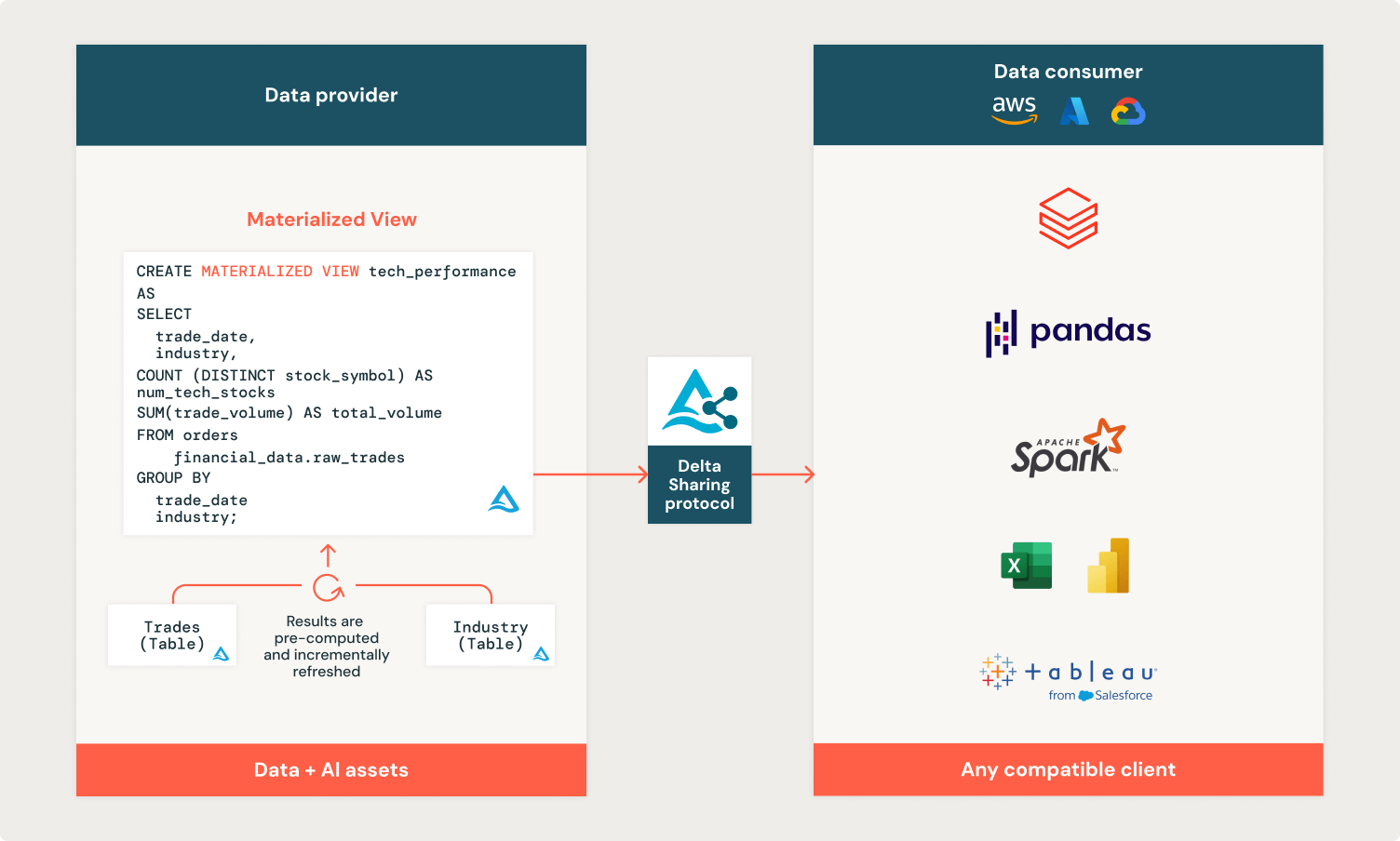Announcing Public Preview of Streaming Table and Materialized View Sharing
Share real-time and precomputed data assets seamlessly with both Databricks users and other platforms

Summary
- Share Materialized Views and Streaming Tables with both Databricks users and other platforms
- Data providers can improve performance and reduce costs while delivering fresh and relevant data to the recipients
- Kaluza uses Materialized View sharing to speed up energy innovation and simplify partner integration
We are thrilled to announce that the sharing of materialized views and streaming tables is now available in Public Preview. Streaming Tables (STs) continuously ingest streaming data, making them ideal for real-time data pipelines, while materialized Views (MVs) enhance the performance of SQL analytics and BI dashboards by pre-computing and storing query results in advance.
In this blog post, we will explore how sharing these two types of assets enables data providers to improve performance, and reduce costs while delivering fresh data and relevant data to data recipients.

Understanding Materialized Views and Streaming Tables
Materialized views (MVs) and Streaming tables (STs) both support incremental updates, which helps keep data current and queries efficient.
- Streaming tables are used to ingest real-time data, often forming the "bronze" layer where raw data lands first. They're useful for sources like logs, events, or sensor data.
- Materialized views are better suited for the "silver" or "gold" layers, where data is refined or aggregated. They help reduce query time by precomputing results instead of scanning full base tables.
Both can be used together—for example, streaming tables handle ingesting sensor readings, while materialized views run continuous calculations, such as detecting unusual patterns.
Read this blog to learn more about Streaming Tables and Materialized Views
Why do data providers need to share ST?
Sharing streaming tables (STs) allows data recipients to access live, up-to-date data without duplicating pipelines or replicating data. Consider a scenario where a retail company needs to share real-time sales data with a logistics partner to support near real-time delivery optimization.
- The company builds and maintains a streaming table in Databricks that continuously ingests transactional data from its e-commerce platform. This table captures events such as product purchases, updates inventory levels, and reflects the current state of sales activity.
The company uses Delta Sharing to share the streaming table. This is done by creating a share in Databricks and adding the table with the following SQL command:
- The logistics partner is provided with credentials and configuration details to access the shared streaming table from their own Databricks workspace.
- The logistics partner uses the live sales data to predict delivery hotspots, update vehicle routes in real time, and improve package delivery speed in high-demand areas.

By sharing streaming tables, the logistics partner avoids building redundant ETL pipelines, lowering complexity and infrastructure costs. Delta Sharing enables cross-platform access, so data consumers don't need to be on Databricks. Streaming tables can be shared across clouds, regions, and platforms.
The data provider retains full control over access, using fine-grained permissions managed through Unity Catalog.
Watch this demo to see how a data provider can share ST with both Databricks users and other platforms
Why do data providers need to share MV?
Sharing only the Materialized Views rather than the raw base tables improves data security and relevance. It ensures that sensitive or unnecessary fields from the underlying data remain hidden, while still providing the consumer with the specific insights they need. This approach is especially useful when the consumer is interested in aggregated or filtered results and does not require access to the full source data.
For example, consider a data provider that monetizes financial market insights. They process raw transactions, such as stock market trades, and create valuable aggregated insights (e.g., the daily performance of industry sectors). A hedge fund (the customer) needs daily insights about the financial performance of technology stocks but does not want to process large volumes of raw transaction data.

Instead of sharing raw trade data, data providers can create a curated dataset to provide hedge funds with precomputed insights that are easier to use and interpret.
- The data provider builds aggregated trade data to calculate the technology sector's daily performance and stores the result as a materialized view. This MV offers ready-to-use, pre-aggregated insights for downstream consumers like the hedge fund.
The provider adds this MV to a secure share object and grants access to the customer's recipient credentials:
- The hedge fund retrieves the shared MV using analytics tools such as Python, Tableau, or Databricks SQL. If using Databricks, the recipient can mount the share directly in Unity Catalog. Delta Sharing ensures interoperability where MVs can be shared across different platforms, tools (e.g., Apache Spark™, Pandas, Tableau), and clouds without being locked into a single ecosystem.
- The hedge fund can directly use this pre-computed data to drive decisions, such as adjusting their investment in technology stocks.
The data provider has avoided managing complex, custom pipelines for each customer. Creating and sharing MVs means there is no longer a need to maintain multiple versions of the same data. All the unneeded details from base tables remain protected while still satisfying the recipient’s data needs. The data recipient gets instant access to the curated data and spends resources on analysis rather than data preparation.
Watch this demo to see how a data provider can share MV with both Databricks users and other platforms.
When to use Views vs Materialized Views?
Delta Sharing also supports cross-platform view sharing, which allows data providers to share views using the Delta Sharing protocol. While materialized views are useful for sharing pre-aggregated results and improving query performance, there are cases where views may be a better fit. Delta Sharing also supports sharing views across platforms, clouds, and regions. Unlike materialized views, views are not precomputed—they are evaluated at query time. This makes them suitable for scenarios that require real-time access to the most current data or where different consumers need to apply their own filters on the fly. Views offer more flexibility, especially when performance optimization is less critical than data freshness or query-specific customization.
How Kaluza is Sharing Materialized Views with Energy Partners
Kaluza is an advanced energy software platform that enables energy suppliers to transform operations, reinvent the customer experience and optimise energy to accelerate the transition to a cheaper, greener electricity grid.
Energy providers face increasing complexity in managing data from growing numbers of connected devices, including electric vehicles, heat pumps, solar panels and batteries as well as a more volatile energy system and complex customer needs. Traditional architectures struggle to deliver real-time insights and operational efficiency at scale.
MV/ST sharing will enable an out-of-the-box solution that enables the Kaluza platform to operate with reduced engineering complexity. Through pipelines that output materialized views, Kaluza enables its partners to access modelled data and reports for actionable insights. This approach streamlines collaboration, reduces integration overhead, and accelerates the delivery of new customer propositions across markets.
“The scale and complexity of energy data demands cross-industry collaboration and knowledge sharing. Delta Sharing materialized views facilitates seamless integration with energy suppliers, supporting grid decarbonisation and driving value for both system stakeholders and customers.”— Thomas Millross, Data Engineering Manager, Kaluza
To wrap things up, sharing Streaming Tables and Materialized Views makes it easier to deliver fresh, real-time insights while cutting down on costs and complexity. Whether you’re sharing live data streams or pre-computed results, MV/ST sharing helps you focus on what matters—making better decisions faster. MV/ST Sharing is now available in Public Preview. Give it a try!

